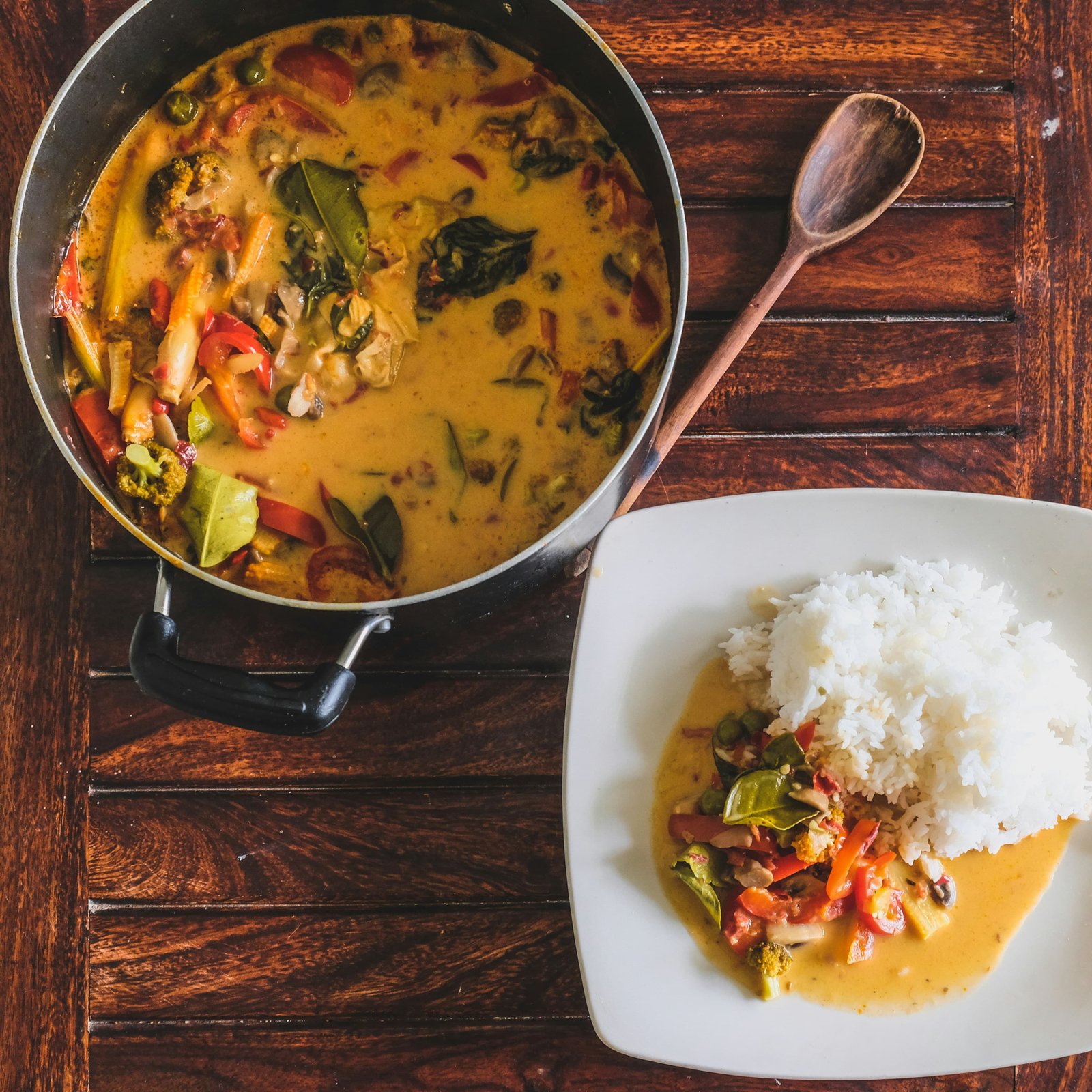
Delicious and Nutritious: Healthy Recipes from Indian Cuisine
Introduction to Indian Cuisine
Indian cuisine is renowned for its rich diversity and vibrant flavors, significantly shaped by the country’s culture, geography, and history. This culinary landscape reflects an intricate tapestry of regional ingredients, cooking techniques, and traditional practices. Each region offers its unique dishes influenced by available local produce, climate, and cultural traditions. The use of fresh ingredients, aromatic spices, and a variety of cooking methods contributes to the distinctiveness of dishes, making Indian cuisine a sensory delight.
Spices form the backbone of Indian cooking, not only enhancing flavor but also adding nutritional value. Ingredients such as turmeric, cumin, coriander, and cardamom are staples that provide depth and complexity to dishes. Moreover, these spices are often celebrated for their health benefits, promoting digestive health, anti-inflammatory properties, and overall well-being. Consequently, Indian cuisine places a strong emphasis on healthy eating practices, especially within vegetarian dishes. This dietary focus aligns with the values of many communities in India, where vegetarianism is a way of life rooted in cultural and spiritual beliefs.
Additionally, the significance of food in Indian culture extends beyond nourishment; it plays a pivotal role in social gatherings, festivals, and rituals. Meals are often enjoyed together, reinforcing familial bonds and community ties. Indian cuisine is not just about sustenance; it embodies the essence of hospitality and tradition, where serving a meal is regarded as an expression of love and care. Thus, exploring Indian cuisine offers an opportunity to appreciate not only its flavors but also the cultural narratives woven into its preparation and consumption.
In essence, the rich and diverse nature of Indian cuisine makes it a compelling subject for both culinary enthusiasts and health-conscious individuals. By focusing on fresh, whole ingredients and incorporating a medley of spices, Indian cooking presents numerous options for delicious and nutritious meals, particularly through its array of vegetarian recipes.
The Health Benefits of Indian Spices
Indian cuisine is renowned not only for its vibrant flavors but also for the generous use of spices, each offering unique health benefits. Turmeric, a staple in many Indian dishes, contains curcumin, a powerful compound known for its potent anti-inflammatory and antioxidant properties. Regular consumption of turmeric may help reduce the risk of chronic diseases such as heart disease and diabetes, making it a valuable addition to a healthy diet.
Cumin, another key spice found in Indian cooking, is rich in antioxidants and has been linked to improved digestion. Studies suggest that cumin may enhance the activity of digestive enzymes, potentially leading to better nutrient absorption. Furthermore, cumin seeds, traditionally consumed for their carminative properties, can alleviate bloating and gas, thereby promoting gastrointestinal health.
Coriander, often used in both its seed and fresh leaf forms, is celebrated for its detoxifying abilities. This spice may assist in cleansing the body of harmful substances, as well as supporting liver function. Additionally, coriander contains antimicrobial properties, which can help combat certain infections when included regularly in meals.
Ginger, widely utilized in a variety of Indian dishes, is praised for its ability to alleviate digestive discomfort and nausea. Its anti-inflammatory effects can also provide relief from muscle soreness and joint pain. Incorporating ginger into the diet is an effective way to harness these benefits, whether through fresh slices, powdered form, or as tea.
Overall, the spices commonly featured in Indian cuisine provide a wealth of health benefits. By understanding and embracing the properties of spices like turmeric, cumin, coriander, and ginger, individuals can enhance their culinary experiences while simultaneously promoting their health and well-being.
Essential Ingredients for Healthy Indian Dishes
Indian cuisine is renowned for its vibrant flavors and rich nutritional profile, achieved through the use of a variety of wholesome ingredients. The essence of healthy Indian dishes often lies in the incorporation of legumes, whole grains, and seasonal vegetables, each contributing to a balanced diet.
Legumes, including lentils, chickpeas, and kidney beans, are staple ingredients in many Indian dishes. They are an excellent source of plant-based protein, which is crucial for muscle building and repair. Additionally, legumes are packed with dietary fiber, promoting digestive health and providing a sense of fullness, which can aid in weight management. The variety of legumes available allows for diverse meal options, catering to different tastes and culinary preferences.
Whole grains play an equally vital role in healthy Indian cooking. Brown rice, quinoa, and whole wheat flour are preferred over their refined counterparts, as they retain their nutrient density. Whole grains are rich in B vitamins, iron, and magnesium, essential for energy production and overall well-being. Furthermore, the fiber found in whole grains aids in maintaining stable blood sugar levels, making these ingredients ideal for those seeking to manage diabetes.
Seasonal vegetables are another cornerstone in the preparation of nutritious Indian dishes. Incorporating a diverse range of fresh, organic produce not only enhances the flavor profile but also ensures a high intake of vitamins and minerals. Vegetables such as spinach, cauliflower, and eggplant are packed with antioxidants, offering significant health benefits. It is advisable to prioritize local and seasonal sourcing of vegetables, as they often contain higher nutrient levels and support sustainable agricultural practices.
In summary, the foundation of healthy Indian recipes is built upon the careful selection of ingredients like legumes, whole grains, and seasonal vegetables. These components provide essential nutrients, supporting overall health and well-being, and contribute to the rich tapestry that defines Indian cuisine.
Vegetarian Curry: A Nutrient-Packed Dish
Vegetarian curry is a central component of Indian cuisine, celebrated for its vibrant flavors and rich nutritional profile. The dish is often characterized by a diverse blend of vegetables, legumes, and aromatic spices, making it a versatile choice for both vegetarians and meat-eaters alike. The base of any good curry generally includes ingredients such as tomatoes, onions, and garlic, which provide a depth of flavor while contributing essential vitamins and minerals.
One of the key features of vegetarian curry is its ability to incorporate an array of vegetables—like spinach, cauliflower, and peas—which not only enhance the dish’s visual appeal but also offer a variety of health benefits. For instance, leafy greens such as spinach are rich in iron and antioxidants, while legumes like chickpeas and lentils provide significant amounts of protein and dietary fiber. This makes vegetarian curry an excellent option for anyone seeking a balanced diet. Furthermore, the inclusion of turmeric and cumin, common spices in many Indian curries, can contribute to anti-inflammatory properties, promoting overall health.
The adaptability of vegetarian curry makes it suitable for various dietary requirements. For those who are gluten intolerant, gluten-free grains like quinoa or rice can be served alongside the curry. Additionally, vegan adaptations can be made by substituting cream or yogurt with coconut milk or cashew cream, ensuring that the dish remains rich and satisfying. The balance of flavors—sweet, salty, bitter, and spicy—can also be easily adjusted to cater to different palates, which is a defining trait of Indian cooking.
In essence, vegetarian curry is not only a delightful dish but also a nutritionally sound choice that aligns with diverse dietary preferences. Its combination of ingredients and flavors allows it to maintain its integrity while delivering health benefits, making it a staple for anyone looking to explore the realms of healthy eating through Indian cuisine.
Healthy Recipe #1: Chickpea Curry
Chickpea curry, or Chana Masala, is a popular dish that embodies the essence of Indian cuisine. Rich in protein and fiber, this dish is not only flavorful but also nutritive, making it an ideal meal for health-conscious individuals. Below is a detailed recipe, including the ingredients, preparation steps, and cooking tips to ensure you create a delicious chickpea curry that is low in fat and high in nutritional value.
Ingredients:
- 1 can (15 oz) chickpeas, rinsed and drained
- 1 medium onion, finely chopped
- 2 medium tomatoes, pureed
- 2 cloves garlic, minced
- 1-inch piece of ginger, grated
- 1 green chili, slit (optional)
- 2 teaspoons cumin seeds
- 1 teaspoon coriander powder
- 1 teaspoon turmeric powder
- 1 teaspoon garam masala
- 2 tablespoons olive oil or water for sautéing
- Salt to taste
- Fresh cilantro, for garnish
Preparation Steps:
- In a large pan, heat olive oil over medium heat. Add cumin seeds and let them splutter.
- Add the chopped onions and sauté until they turn translucent.
- Stir in the garlic, ginger, and green chili, cooking for an additional minute to release their aromas.
- Add the pureed tomatoes, coriander powder, turmeric powder, and salt; cook until the mixture thickens and oil separates from the masala.
- Incorporate the chickpeas and mix well. Add a bit of water if the curry appears too thick.
- Simmer for about 10-15 minutes, allowing the flavors to meld. Stir in the garam masala just before serving.
Cooking Tips:
- For a creamier texture, consider adding a tablespoon of low-fat yogurt at the end of cooking.
- Experiment with additional spices such as cumin powder or chili powder to suit your palate.
- Serve the chickpea curry with brown rice or whole wheat naan for a complete meal.
This chickpea curry offers a perfect balance of flavor and nutrition, suitable for anyone aiming to maintain a healthy lifestyle. With its simplicity and versatility, it can easily become a regular part of your weekly meal planning.
Healthy Recipe #2: Spinach and Tomato Curry
Spinach and tomato curry is a delightful dish that brings forth the vibrant flavors of Indian cuisine while providing numerous health benefits. Spinach, known for its rich content of vitamins A, C, and K, is widely recognized for its antioxidant properties. The incorporation of fresh spinach in this curry not only enhances its nutritional profile but also adds a unique earthy flavor to the dish. Tomatoes, on the other hand, are a great source of lycopene, a powerful antioxidant that is linked to various health benefits, including heart health and cancer prevention.
The recipe for spinach and tomato curry is both straightforward and adaptable, making it suitable for various dietary preferences. To begin, gather fresh spinach, ripe tomatoes, onions, garlic, and a selection of spices such as cumin, turmeric, and garam masala. Sauté the onions and garlic until they are golden brown, then add the chopped tomatoes and cook until they soften. Once the tomatoes are cooked, add the fresh spinach, stirring until it wilts while retaining its bright green color. The addition of spices not only enhances the flavor but also contributes to the overall healthiness of the dish.
It is crucial to utilize cooking methods that preserve the nutrients in both spinach and tomatoes. Overcooking can lead to a reduction in the vitamin content, especially with spinach. Therefore, aim to cook the spinach just until it is wilted, allowing it to maintain its nutritional essence. Making this curry a regular part of your meal plans not only supports a healthy diet but introduces a burst of flavor, making it a favorite among family and friends alike.
Healthy Recipe #3: Lentil Dal
Lentil Dal is a quintessential dish in Indian cuisine, known not only for its rich flavor but also for its impressive nutrition profile. This traditional lentil dish is easy to prepare and is a fantastic source of protein and fiber, making it an excellent choice for those seeking a healthy meal that is both comforting and satisfying. The primary ingredient, lentils, come in various types, each contributing unique flavors and health benefits.
To prepare a basic lentil dal, begin by rinsing one cup of lentils—red lentils (masoor dal) or green lentils (moong dal) are popular choices—and soaking them for 10 to 15 minutes. Once soaked, drain the lentils and place them in a pot with four cups of water, adding chopped onions, tomatoes, turmeric, and salt for flavor. Allow the mixture to boil, then reduce the heat and let it simmer until the lentils are tender, usually around 20-30 minutes. For added depth of flavor, many cooks like to incorporate spices such as cumin, coriander, and garam masala, adding complexity to this wholesome dish.
Beyond its savory taste, the health benefits of lentil dal are noteworthy. Lentils are high in protein, making them an ideal substitute for meat in vegetarian diets. They are also rich in dietary fiber, which promotes a healthy digestive system. Furthermore, lentils provide essential vitamins and minerals, including folate, iron, and magnesium, contributing to overall health and well-being. With its adaptability, lentil dal can be easily modified to include a variety of vegetables, such as spinach or carrots, enhancing both its nutritional value and flavor.
Incorporating lentil dal into your meal rotation not only results in a healthy and delicious dish but also honors traditional Indian culinary practices. Whether served with rice or bread, this dish is sure to be a hearty, satisfying choice for a nutritious meal.
Serving Suggestions and Pairings
When it comes to enjoying healthy Indian dishes, serving suggestions and pairings play a pivotal role in enhancing not only the flavor but also the nutritional value of the meal. To create a well-balanced and satisfying meal, consider incorporating a variety of side dishes, rice options, and bread pairings that complement the main curry or vegetable preparation.
For side dishes, consider adding a refreshing cucumber and tomato salad, known as kachumber. This simple salad can lighten the meal while providing crucial vitamins and minerals. Additionally, various pickles, such as mango or lime pickle, can enhance the taste profile of the dishes and add a burst of flavor. Another great option is a side of raita, a yogurt-based condiment, which offers a cooling effect that balances spicy dishes effectively.
When it comes to rice, basmati rice stands out as a classic pairing for many Indian curries. Its fluffy texture and aromatic flavor complement the sauces well. Alternatively, for a healthier option, opt for brown basmati rice or quinoa, which adds more fiber and nutrients to your meal. Both options serve as an excellent base to soak up savory curries.
Breads are another wonderful accompaniment that can elevate your dining experience. Whole wheat chapatis or multi-grain naan not only pair wonderfully with curries but also contribute additional fiber and complex carbohydrates. For a gluten-free alternative, consider serving the meal with rice or a side of dosa, a traditional South Indian rice pancake. This variety offers additional protein and can be a superb option for those following a gluten-free diet.
By thoughtfully selecting side dishes, rice options, and bread pairings, one can create a delicious and wholesome Indian meal. Such pairings not only enhance the flavors of each dish but also ensure a more nutritionally balanced plate, making each dining experience both satisfying and healthy.
Conclusion: Embracing Healthy Indian Cuisine
In recent years, there has been a growing awareness of the importance of healthy eating and the impact it has on overall well-being. Indian cuisine, with its rich tapestry of flavors, spices, and cooking techniques, offers a plethora of opportunities for those looking to adopt healthier eating habits while still enjoying delicious meals. By embracing healthy Indian food, individuals can experience a wide variety of nutrient-dense ingredients, which are often incorporated into traditional recipes.
Indian cuisine is known for its use of vibrant spices such as turmeric, cumin, and coriander, each possessing unique health benefits. These spices not only enhance taste but also contribute to improved digestion, reduced inflammation, and increased antioxidant levels in the body. By experimenting with these spices and incorporating more vegetables, whole grains, and legumes into their meals, readers can create wholesome dishes that nourish both body and soul.
Moreover, healthy Indian recipes can be easily adapted to suit personal taste preferences and dietary restrictions. Whether one follows a vegetarian or vegan lifestyle or prefers gluten-free options, the versatility of Indian cuisine allows for endless variations. From hearty lentil dals to fragrant vegetable curries, these dishes can be prepared in a manner that maintains their authenticity while aligning with individual health goals.
As with any culinary tradition, discovering the world of healthy Indian recipes can be a delightful exploration. As readers begin to try these recipes, they will likely find that healthy eating does not mean sacrificing flavor or satisfaction. Instead, it opens the door to new experiences and a deeper appreciation for the profound diversity that Indian cuisine has to offer. Embrace these flavors, share them with others, and enjoy the journey to a healthier lifestyle through the joy of cooking and eating well.


